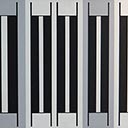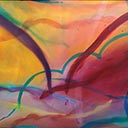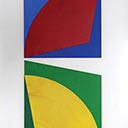Snake Charmer
150 x 182 cm
est. $15,000 - 20,000
 Relative size
Relative size
Provenance:
Purchased by Fletcher Challenge Ltd Bosshard Galleries, Dunedin, 1977
Fletcher Trust Collection
Exhibited:
Elva Bett Galleries, 1976
Bosshard Galleries, Dunedin, 1977, no. 15
Original label's from both galleries affixed verso
Gretchen Albrecht's signature arc sweeps across Snake Charmer with its curved lines suggesting the sway of the snake charmer's body and mesmerising flute; and the arc that later became synonymous with her name is explicitly foreshadowed here with great confidence and grace.
Gretchen Albrecht was born in Auckland where she continues to live and work. She studied at Elam School of Fine Arts, the University of Auckland - where later she was Teaching Fellow in Painting from 1972 to1973 - and unlike many of her contemporaries who travelled immediately after art school, Albrecht did not go overseas until after a decade of developing her practice. Snake Charmer comes from what the artist considered to be the emergence of her mature style in the 1970s.
It was a period where she secured her vision and reputation as a leading abstract painter in a manner similar to that of American artist Helen Frankenthaler who in the late 1960s evolved a form of abstraction with transparent bands of horizontal colour.
Following a decade of colour-field paintings that explored stacked and layered chromatic relationships, the hemispheres that emerged after Albrecht's year away in the USA and Europe, and during her Frances Hodgkins Fellowship in Dunedin from 1981 to 1982 were a shock for New Zealand audiences: shaped canvasses replaced the standard rectilinear stretchers; bold solid colours replaced the watercolour-inspired washes and transparency; and strident contrasts replaced previously more subtle shifts of hue.
All this, at the time, perhaps obscured the constancy of Albrecht's gesture and the way the dimensions of her works corresponded to the scale and expression of her body.
In Snake Charmer we can see the familiar wide sweep of her extended arm in the two red arcs which plunge from the centre up to the left and right corners; and in the three blue arcs that traverse the canvas from lower left to high on the right-hand edge. These are the same as those that come to define the hemispheres which first emerge in 1981. It is the same body, the same painterly gesture; but the artist has shifted her expression dramatically and extended her vernacular.
The hemispheres of the early 1980s owe much to the artist's travels in 1979, but they also owe much to her own painting that preceded them; and the power of Snake Charmer lies in its complete maturity as a painting as well as in the story it tells of a moment in which the artist created a bridge to a new way of working.
ROB GARRETT




